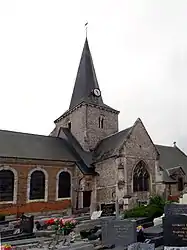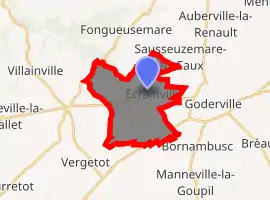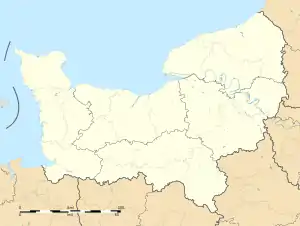Écrainville
Écrainville is a commune in the Seine-Maritime department in the Normandy region in northern France.
Écrainville | |
|---|---|
 The church in Écrainville | |
Location of Écrainville 
| |
 Écrainville  Écrainville | |
| Coordinates: 49°39′09″N 0°19′17″E | |
| Country | France |
| Region | Normandy |
| Department | Seine-Maritime |
| Arrondissement | Le Havre |
| Canton | Saint-Romain-de-Colbosc |
| Intercommunality | CC Campagne de Caux |
| Government | |
| • Mayor (2020–2026) | Claire Gueroult |
| Area 1 | 12.82 km2 (4.95 sq mi) |
| Population (2017-01-01)[1] | 1,022 |
| • Density | 80/km2 (210/sq mi) |
| Time zone | UTC+01:00 (CET) |
| • Summer (DST) | UTC+02:00 (CEST) |
| INSEE/Postal code | 76224 /76110 |
| Elevation | 58–137 m (190–449 ft) (avg. 110 m or 360 ft) |
| 1 French Land Register data, which excludes lakes, ponds, glaciers > 1 km2 (0.386 sq mi or 247 acres) and river estuaries. | |
Geography
A farming commune made up of 11 villages and hamlets in the Pays de Caux, situated some 13 miles (21 km) northeast of Le Havre, at the junction of the D68 and D139 roads.
History
The origin of the name is uncertain, but Escrainvilla is first mentioned at the end of the 12th century. Many documents trace the occupation of the territory at the time of the Franks and even earlier. Abbé Dicquemare described, in 1778, the 150 human skeletons found in the crypt at the former quarry at Maucomble at Val-Miellé, and suggests that the crypt was prior to the 11th century, as the church of Saint-Denis dates from that period.
The first written mention of Écrainville or one of its hamlets dates back in the late 11th century. In 1180, the lord of Tennemare or Tannemare appeared in the records of the Exchequer of Normandy. Until the 17th century, the seigneurie passed from father to son of the Folville family.
A decree of 25 October 1826 joined Tennemare and Écrainville as one commune. In the 19th century the textile industry was still flourishing but declined from the 1920s onward.
Population
| Year | 1962 | 1968 | 1975 | 1982 | 1990 | 1999 | 2006 |
|---|---|---|---|---|---|---|---|
| Population | 618 | 657 | 683 | 866 | 919 | 928 | 1020 |
| From the year 1962 on: No double counting—residents of multiple communes (e.g. students and military personnel) are counted only once. | |||||||
Places of interest
- The church of St. Denis, dating from the eleventh century.
- A seventeenth century inn.
- The medieval manorhouse at Groseillers.
- The château d'Ecrainville.
References
- "Populations légales 2017". INSEE. Retrieved 6 January 2020.
| Wikimedia Commons has media related to Écrainville. |